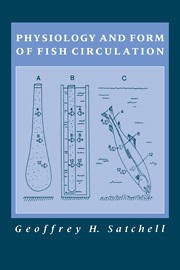Book contents
- Frontmatter
- Contents
- Preface
- 1 Introduction
- 2 The Heart
- 3 The peripheral circulation
- 4 The blood
- 5 Haemopoiesis and phagocytosis - the mononuclear phagocytic system
- 6 Circulation through special regions
- 7 Retial counter-current systems: flow–diffusion–concentration
- 8 Venous return and venous pumps
- 9 The autonomic nervous system
- 10 The response to exercise
- 11 The response to hypoxia
- 12 Myxine, a speculative conclusion
- References
- Appendix of popular and scientific names
- Index
12 - Myxine, a speculative conclusion
Published online by Cambridge University Press: 05 February 2012
- Frontmatter
- Contents
- Preface
- 1 Introduction
- 2 The Heart
- 3 The peripheral circulation
- 4 The blood
- 5 Haemopoiesis and phagocytosis - the mononuclear phagocytic system
- 6 Circulation through special regions
- 7 Retial counter-current systems: flow–diffusion–concentration
- 8 Venous return and venous pumps
- 9 The autonomic nervous system
- 10 The response to exercise
- 11 The response to hypoxia
- 12 Myxine, a speculative conclusion
- References
- Appendix of popular and scientific names
- Index
Summary
Introduction
Myxine, the Atlantic hagfish, is the best known genus of a group of fish-like creatures, the myxinoids. Since the classical studies of Müller in the thirties of the last century, their status has puzzled biologists, for they combine many clearly primitive features with others which seem quite specialized. They are the only vertebrates in which the concentration of inorganic ions in the body fluids is sufficiently high to render them isosmotic with sea water, and they have no ability to osmoregulate. It is true that many elasmobranchs are isosmotic with sea water, but in such fish this is achieved by the retention of urea as ‘osmotic stuffing’. Myxinoid haemoglobins are monomeric, with molecular weights around 17500, and are thus more like circulating myoglobins than the tetrameric haemoglobins of fish. They lack true jaws derived, as these are in other vertebrates, from the gill arch of the second head segment, and their visceral arches are rudimentary and are not hinged to the skull but are direct extensions of it. Their gill lamellae occur inside sac-like pouches into and out of which water is pumped by encircling bands of muscle, an arrangement quite different from that of fish in which the whole pharynx is expanded and compressed by the hinged elements of the gill bars and the muscles that run between them. The alimentary canal is a straight tube and there is no true pancreas, for the islet cells are coalesced to form a little knot of tissue at the anterior end of the intestine, and the zymogen cells are scattered throughout the intestinal epithelium.
- Type
- Chapter
- Information
- Physiology and Form of Fish Circulation , pp. 183 - 197Publisher: Cambridge University PressPrint publication year: 1991



